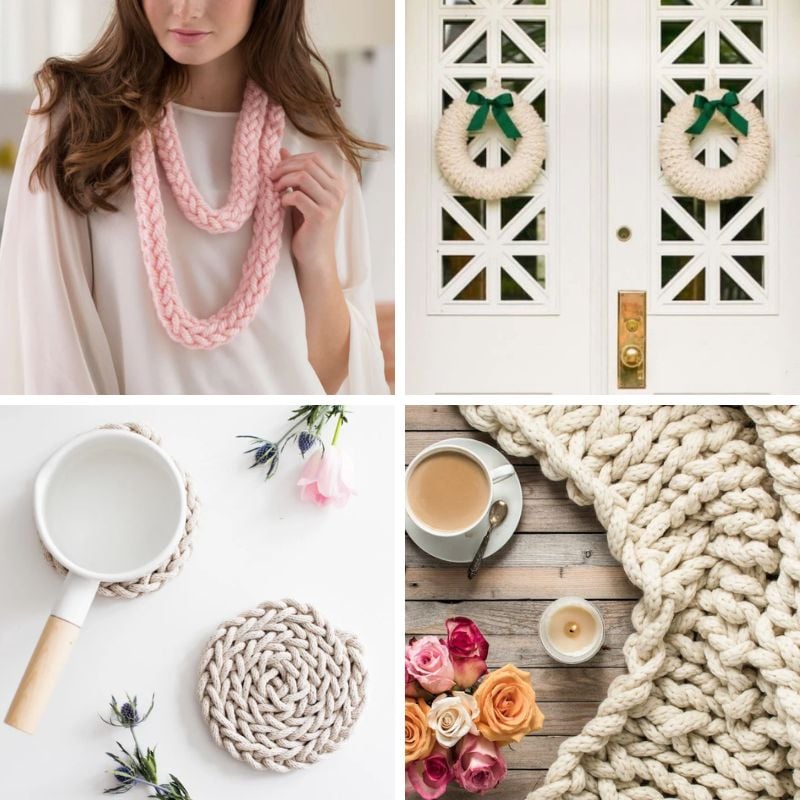Knitting With Alternative Materials (Creative Ideas)
THIS ARTICLE CONTAINS AFFILIATE LINKS THAT SUPPORT HANDY LITTLE ME CONTENT AND FREE PATTERNS.Looking for a new way to knit that’s fun, sustainable, and totally outside the box?
This blog post explores knitting with alternative materials—a creative and eco-conscious way to craft one-of-a-kind pieces.
Whether you’re short on supplies or simply curious about experimenting with unusual textures, there are plenty of exciting options to try.
From fabric strips and plarn to wire, linen, and ribbon, you’ll learn how to swap out traditional tools and yarn for everyday materials—all while reducing waste and boosting your creativity.

What Are Knitting Needles?
Knitting needles are long, slender tools used to create fabric from yarn by forming loops and stitches.
They come in a variety of materials like wood, bamboo, plastic, or metal needles, and can vary in tip style, size, and length.
The material and shape of the needles affect the tension, texture, and ease of your knitting experience.
Related Post: Best Knitting Needles For Beginners
Alternative Knitting Needle Ideas: What to Use When You Don’t Have Needles
Need a quick substitute? Try these household items:
- Chopsticks
- Wooden pencils
- Smooth dowels
- Paintbrush handles
Make sure the item is smooth, splinter-free, and close in size to your intended needle.
Sand rough edges or wrap with tape for a better grip.
For circular knitting: Try using multiple straight rods or switching to flat knitting with straight tools.
It requires some adjustment, but it works in a pinch.
If you crochet as well, some of these concepts can be transferred by using hooks and loops similarly.
Related Post: How To Join Knitting In The Round With Circular Knitting Needles
Can You Knit Without Needles?
Yes! Here are four needle-free knitting methods:
- Finger Knitting (Best for scarves & accessories)
- Arm Knitting (Great for chunky blankets)
- Loom Knitting (Perfect for hats and socks)
- Peg/Board Knitting (Ideal for wide scarves or shawls)
Each method allows you to create beautiful pieces with just your hands or simple tools.

What Can I Use Instead of Yarn? 10 Eco-Friendly Yarn Alternatives
Knitting without yarn? Try these creative materials:
- Fabric strips (Old t-shirts or bedsheets)
- Ribbon (Satin, grosgrain, organza)
- Plarn (Plastic bags turned into “plastic yarn”)
- Embroidery floss or thread
- Rope or twine
- Shoelaces
- Wire (For jewelry or sculpture)
- VHS/cassette tape
- Leather or suede strips
- Beaded strands on thread or line
You can also use t-shirt yarn, which is soft, stretchy, and incredibly durable for items like rugs, baskets, and bags.
Whether you’re working with organic cotton, linen, wool, or even silk, understanding how your material behaves is key.
Benefits of Knitting With Alternative Materials
- Eco-Friendly — Reduce waste by upcycling old items.
- Budget-Conscious — Save money by using what you already have.
- Creative Freedom — Experiment with textures and colors.
- Personal Expression — Each piece is one of a kind.
Exploring colorways and semi-solid yarn adds depth to your pieces.
However, be mindful of noticeable pooling or a distinct line when switching to a second skein.
These small variations are normal, especially with hand-dyed yarns like Feliz or tonal semi-solids.
Are the techniques the same?
Yes, but you may need to tweak your approach:
- Needle size: Use larger needles for thicker materials like fabric or rope.
- Tension: Loosen tension for stiff or non-stretchy materials like wire.
- Stitch choice: Garter stitch works best for bulky or rigid materials, while stockinette stitch may curl depending on the yarn used.
- Finishing: Tie knots, use glue, or sew ends, depending on the material.
When using skeins of yarn, especially from different dye lots, you might want to alternate rows from each new skein to blend the colors evenly and avoid harsh transitions.
This carry-up method helps minimize sharp contrasts between semi-solid vs more variegated yarns.
How to Start Knitting With Alternative Materials (Beginner Tips)
- Choose a simple project (swatch, scarf, coaster)
- Select your alternative yarn or tool
- Knit a gauge swatch to test tension and adjust as needed
- Look for inspiration in forums or social groups
Tip: Join our Facebook group or browse Handy Little Me on YouTube for more tutorials.
Trying lace or a bold stitch pattern with an unconventional material adds extra flair, especially with basic stitches that highlight texture.
Free Knitting Patterns
- How To Knit A Hat For Complete Beginners (+ Video Tutorial)
- 20 Temperature Blanket Patterns (The Ultimate Guide)
- How To Knit A Hat With Circular Needles (Step-By-Step)
- 31 Free Baby Blanket Knitting Patterns (Easy Knit Blankets)
- How To Knit Baby Booties (Step-By-Step)
- Knitted Dog Sweater Pattern (3 Sizes)
- Free Knitted Dishcloth Patterns
- 37+ Patterns To Use Up Your Yarn Stash (Small Projects)
- Free Dog Sweater Knitting Pattern (Straight Needles)
- Super Easy Corner To Corner Baby Blanket Pattern (Knit)
- Easy Baby Sweater Knitting Pattern For Beginners
- How To Knit A Baby Hat (Straight Needles)
- Pumpkin Knitting Pattern (Beginner Friendly!)
- 8 Cable Stitch Knitting Patterns
- Free Knitted Heart Pattern (Easy + Quick Project)
- 20+ Fall Oversized Knits (Sweater Knitting Patterns)
- Ribbed Beanie Knitting Pattern (Unisex Mariner’s Hat)
- How To Substitute Yarn In A Knitting Pattern (An Easy Guide)



